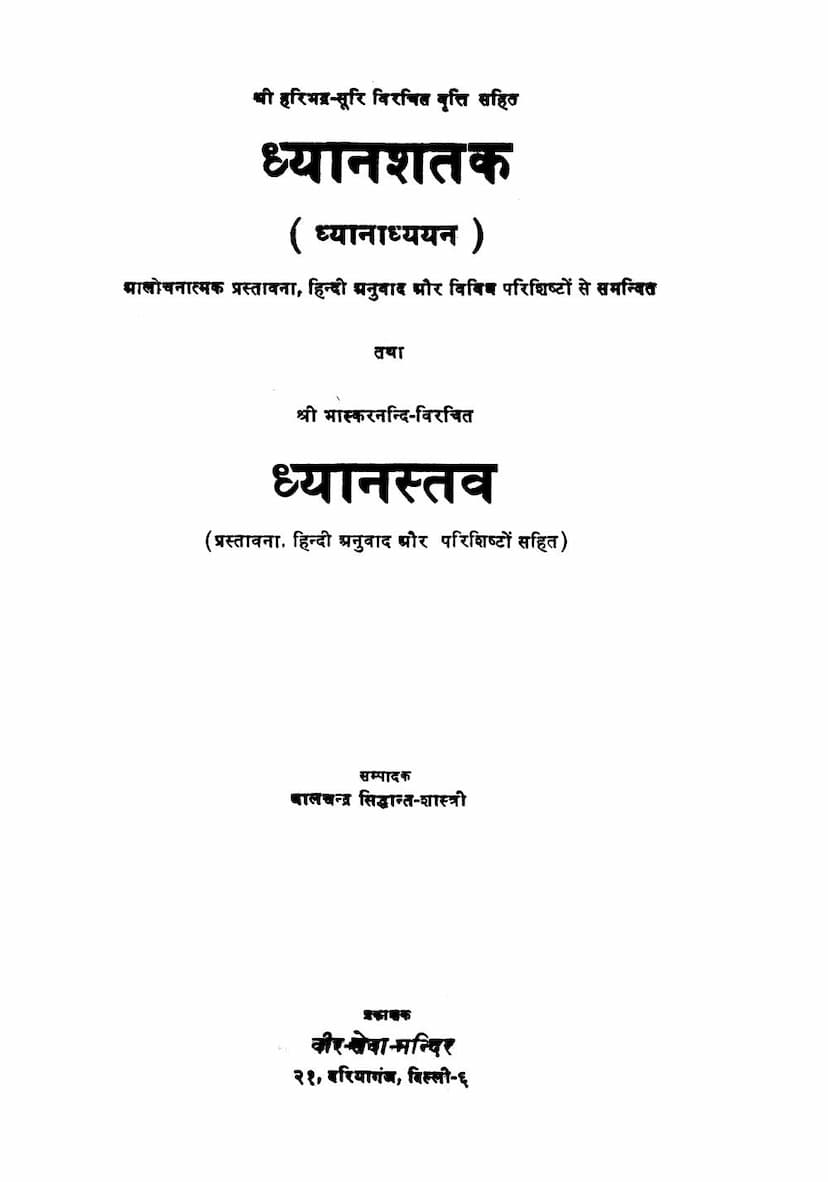Dhyanhatak Tatha Dhyanstava
Added to library: September 1, 2025

Summary
Here's a comprehensive summary of the Jain text "Dhyanhatak Tatha Dhyanstava," based on the provided information:
Title: Dhyanhatak Tatha Dhyanstava (also known as Dhyānāadhyayana)
Authors:
- Haribhadrasuri (Sanskrit Commentary)
- Bhaskarnandi (Dhyanstava)
Editor: Balchandra Siddhanta-Shastri
Publisher: Veer Seva Mandir
Catalog Link: https://jainqq.org/explore/032155/1
Publication Details:
- First Edition: Veer Nirvana Samvat 2502, Vikram Samvat 2032 (1976 CE)
- Price: ₹ 12.00
Overall Content: This book presents two important Jain texts on meditation: "Dhyanśataka" (also called "Dhyānādhyayana") and "Dhyānastava." Both texts offer profound insights into the nature and practice of meditation from different perspectives and in different languages (Prakrit for Dhyanśataka and Sanskrit for Dhyānastava). The edition includes critical editing, Sanskrit commentary (for Dhyanśataka), Hindi translations, introductions, and appendices, making it a valuable resource for understanding Jain meditation practices.
Key Aspects of Dhyanśataka (Dhyānādhyayana):
- Content: It's a poem composed in Prakrit, containing 105 verses (gāthās). The author is unknown but is credited with a significant treatise on Digambara Jain Agamas, particularly focusing on meditation.
- Subject Matter: The text elaborates on the nature of Dhyāna (meditation) and its four primary types:
- Ārta (Sorrowful/Painful): Associated with suffering, pain, and the desire for relief.
- Raudra (Cruel/Fierce): Characterized by anger, violence, and cruelty.
- Dharma (Virtuous/Righteous): Focused on virtuous contemplation, dharma, and righteous actions.
- Śukla (Pure/White): The highest form of meditation, characterized by absolute purity and detachment, leading to liberation.
- Classification of Meditation: The text divides Ārta and Raudra dhyāna as causes of the cycle of birth and death (saṃsāra), while Dharma and Śukla dhyāna are considered causes of liberation (moksha).
- Detailed Descriptions: The book provides detailed descriptions of each type of meditation, including their sub-types, causes, effects, associated mental states (leshya), identifying characteristics (linga), and the spiritual stages (guṇa-sthāna) where they occur.
- Influence: The text shows influence from works like the Tattvārthasūtra of Umāsvāti, particularly in its treatment of meditation.
- Author: While the author of Dhyanśataka is unknown, the concluding 106th gāthā attributes it to Jinabhadra Kshamāshramana. However, the editor and scholars like Pt. Dal Sukhbhai Malvania express doubt about this attribution due to stylistic inconsistencies and the fact that Haribhadra Suri, the commentator, doesn't explicitly mention Jinabhadra as the author in his commentary. It is suggested that the text likely originated around the time of Bhadrabahu and Jinabhadra Kshamāshramana, possibly between the 6th and 8th centuries CE.
Key Aspects of Dhyānastava:
- Author: Bhaskara Nandi.
- Content: A Sanskrit composition of 100 verses (shlokas), considered a well-known exposition of meditation.
- Subject Matter: The text also systematically discusses meditation, including its essential aspects. It is structured as a hymn of praise to the Jinas, integrated with the teachings on meditation. The author seems well-acquainted with Dhyanśataka, which is quoted in the Dhavala commentary.
- Influence: Bhaskara Nandi's work draws upon earlier literature, including the Tattvārthasūtra and its commentaries, as well as works like Dravyasangraha and Amitagati's Śrāvakācāra.
- Author's Life: Limited information is available about Bhaskara Nandi's life. He is known to have written a commentary on Tattvārthasūtra called "Sukhabodhā Vritti." Based on the available scholarship, his time is estimated to be around the 12th century CE, possibly flourishing in the early 12th century AD as a Digambara Pandit.
Key Features of the Edition:
- Critical Editing: The texts have been critically edited by Pt. Balchandra Siddhanta Shastri.
- Commentary: Haribhadra Suri's Sanskrit commentary is included with Dhyanśataka.
- Hindi Translation: Both texts are provided with Hindi translations.
- Introduction: A detailed introduction by the editor provides context, discusses the subject matter, and includes comparative studies with other yogic texts like the Bhagavad Gita and Patanjali Yoga Sutras.
- Appendices: Several important appendices are included, offering detailed analysis of specific terms, indices of verses, and comparative studies with other Jain texts (Moolachara, Bhagavati Aradhana, Tattvarthasutra, Sthananga, etc.).
- Comparative Study: The introduction and appendices highlight the deep influence of earlier Jain scriptures on Dhyanśataka and demonstrate significant parallels in concepts and terminology between Jain philosophy (especially concerning meditation) and other Indian philosophical traditions like Yoga and Vedanta.
Core Jain Principles Highlighted:
- Soul's Nature: Emphasis on the soul's inherent purity and its journey towards self-realization and liberation from karmic bondage.
- Self-Reliance: True happiness is achievable through self-effort and detachment, not external dependency.
- Path to Liberation: The attainment of the soul's true nature (siddhi) is achieved through pure meditation, guided by the Three Jewels (Ratnatraya: Right Faith, Right Knowledge, Right Conduct).
- Importance of Meditation: Meditation is presented as a crucial tool for spiritual upliftment, peace, and the discrimination between what should be adopted and what should be rejected (heyo-padeya viveka).
- Comparison with Other Systems: The work engages in comparative analysis with concepts from the Bhagavad Gita and Patanjali Yoga Sutras, revealing commonalities in the pursuit of spiritual liberation through inner focus and control.
In essence, this book provides a scholarly presentation of two foundational Jain texts on meditation, elucidating the Jaina path to spiritual realization through systematic contemplative practices, while also contextualizing them within broader Indian philosophical discourse.